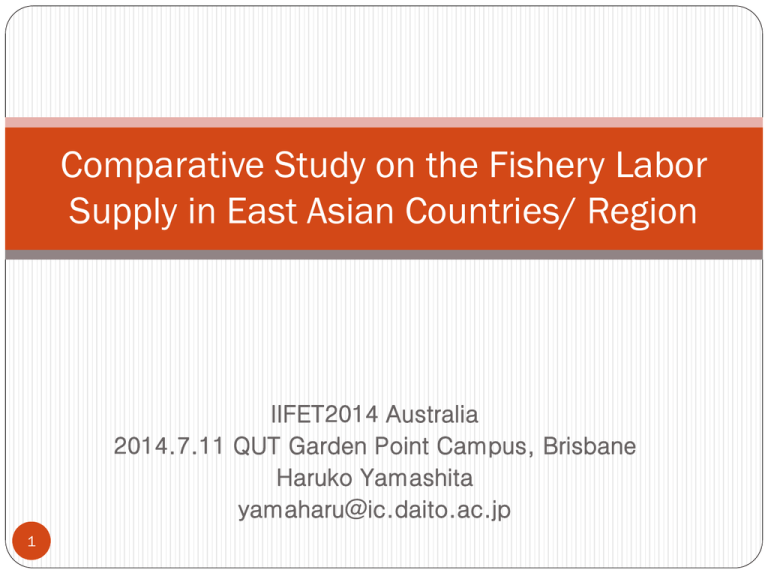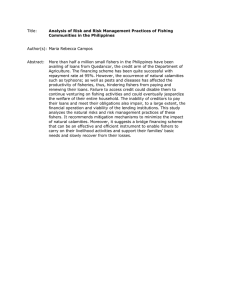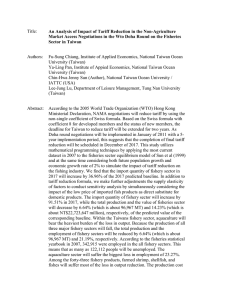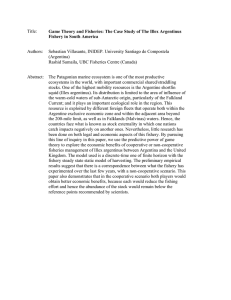Comparative Study on the Fishery Labor
advertisement

Comparative Study on the Fishery Labor Supply in East Asian Countries/ Region IIFET2014 Australia 2014.7.11 QUT Garden Point Campus, Brisbane Haruko Yamashita yamaharu@ic.daito.ac.jp 1 Objectives Aging Fishermen (Japan) Number of new entrants were 2,000/year 34% of fishers were over 65 years old (2008 census) Future issues and challenges Short term: lack of fisher labor supply, decline in production & threatened marine security Long term: shrinking fisheries sector Arguments can be done from various aspects; Over capacity, low income & productivity, retirement, etc. Is this a unique phenomena of Japanese fisheries? If the issue is same in other countries, how do they cope with this? 2 Methodology Compare the Japanese situation with other countries/ regions Characteristics :Large fisheries sector, many alternative job opportunities, high par capita income, similar cultural background Study locations :Taiwan (Mar 2013) and Korea (Jan 2014) Sample: In-depth interviews with government, cooperatives and fishers Data : Primary data composed of both formal/informal and comparisons were made 3 Comparison 1: similar in many ways, but… 4 Taiwan Global solution • Retirement at around 65 • Replace completely with foreign labor force Korea Attracting youth • Trend of aging fishers in the next five years • Attract young labor force by the exemption from military duty Japan In-house solution • Postpone retirement • Aged fishers are willing to perform till industry get replacement Comparison 2: composition of fishers (25.3%) Pingu province 5 Fishers 330,000 (recorded) 160,000 (recorded) 210,000 Offshore Coastal 20,000 60,000 100,000 50,000 14,400 Production 903,905 MT(2011) 1,761,785MT(2011) 3,849,522MT(2011) Population 23mil 50mil 130mil Comparison 3 : Income distribution (unit: 1000US$/year) Taiwan 6 Korea Japan Average household income 38.4 53.9 54.1 Freshman’s salary 10.4 30.0 28.0 Average fishers household income (from fishing) 25.5 37.4 (19.5) 39.0 (22.3) Fisher/non-fisher income 66.4% 69.4% 72.1% Pension (monthly) 25.2 (2.1) (some) 65.4 (5.5) Comparison 4: Institutional Arrangements & the (poor) results Taiwan Korea Japan Institutional arrangement s ✔Program to direct the young people towards farming ✔Policy of supporting retuning people to the farms and fishing villages (subsidy scheme , low interest rate loans, support for start up businesses) ✔Award of US$30k after an year’s work in fishery upon the graduation of fishery highschool/college ✔Large purse-seiners organization recruit high-school graduates (with the privilege of army duty exemption) ✔Employment matching fair for fishery is organized 6 times a year 9% (20 people) of the graduates became fishers/year At one fair in Tokyo, 300 people visited and 5 matches (2%) with fisheries The results of 6 people returned the in one year institutional arrangement 7 Comparison 5: Dependency on foreign workers Taiwan Backgr ✔Common across ound industry and in home ✔150K people work in manufacturing (21K) & services(131K) ✔6,342 Number of foreign ✔Pingu province, fisherme Taiwan Taiwanese 19,000 n in Indonesian 1,100 fisheries Chinese 400 sector Philippi no 86 Wage US$/m Example of working condition s 8 Chinese 600 Others 540 ✔A Taiwanese coastal squid fisherman act as a captain and 5 crews were all foreigners ✔Chinese workers have to stay 12 miles away while others can land Korea Japan ✔Foreign workers were accepted to offshore fishery from 2010 ✔Max 1,000 people ✔3 years + 3 years ✔1,000 ✔Large Purse-seine 300 /1,700crews Offshore Trawl / 2,000 Offshore long line 200 / 300 ✔Indonesian→Chinese→ Vietnamese→Laos, Yammer ✔Foreign trainees were invited from 2005 ✔70K people ✔One year of training and two years of OJT ✔1,782 (1,056 in fishery, 726 in aquaculture) ✔Across industry, Chinese 66.2% Vietnamese, Philippinoe, Indonesian, Thai & Others ✔In the case of Offshore long line (200 out of 300), most of the crews were foreigners ✔Offshore long line seeks to be accepted for army exemption 1st year 500 nd rd 2 ,3 year 800 ✔Coastal fishermen were not used to work with foreigners ✔Fish processing sector heavily dependent on foreign labor Conclusions: sustainability and applicability Taiwan Global solution Korea Catching young Japan In-house solution 9 • Retirement at around age 65 • Complete utilization of foreign labor force • Sustainable solution in the middle term • Possible application to other nations • Trend of aging in the next five years • Attract young labor force by the exemption from military duty • Unique in terms of background • Applicable as “internship opportunity” • Postpone retirement. Aged fishers are willing to perform till they can • Unique in terms of motivated aged workforce • Applicable to the others, i.e. Korean Thank you! (Map of the Pingu province in Taiwan) East-West withe about 18 km 10 Pingu Island, Taiwan province




